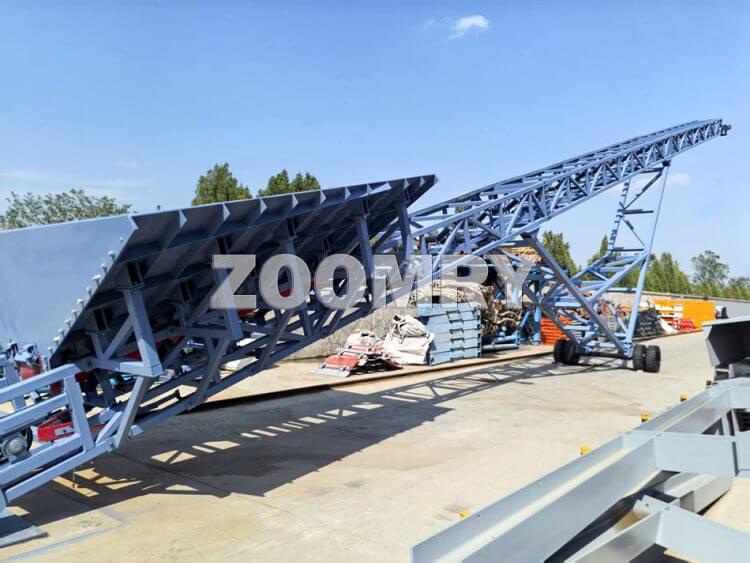The technological development of bulk material conveying systems has always revolved around two core objectives: efficiency improvement and energy consumption reduction. According to data from the internationally renowned consulting firm Global Market Insights, the global market size for bulk material handling equipment has exceeded $12 billion in recent years, with intelligent conveying systems showing a compound annual growth rate as high as 8.7%. This growth stems both from the demand for handling new bulk materials like lithium ore and silicon in the new energy industry and the need for intelligent upgrades of existing equipment in traditional ports and terminals.
In equipment selection, companies must comprehensively consider key parameters such as material characteristics (particle size, moisture, abrasiveness), operating environment (indoor/outdoor, temperature and humidity range), and throughput (single-machine capacity of 500-6,000 tons/hour). Zoomry, a technology-driven enterprise with over two decades of expertise in the bulk material conveying field, provides global customers with efficient and environmentally friendly material handling solutions through its independently developed equipment, including belt conveyors, telescopic stackers, and mobile shiploaders.

Common Bulk Material Handing Equipment
Belt Conveyor
As the most widely used continuous conveying equipment, belt conveyors operate on the principle of friction-driven transmission between an endless belt and drive pulleys, supported by idlers to achieve horizontal or inclined material transport. With a maximum conveying distance of 30 kilometers and a single-machine capacity of up to 6,000 tons/hour, they are extensively applied in mining, port terminals, and coal-fired power plants. Key technical features include support for horizontal, inclined (up to 30°), and three-dimensional curved conveying, adaptable to various materials such as ores, coal, and grains.
Zoomry’s curved conveying system employs specially designed idler sets to achieve composite-angle turning of 30° vertically and 15° horizontally, enabling continuous conveying across complex terrains without transfer points. This reduces energy consumption by 25% and extends maintenance intervals to 20,000 hours.
telescopic stacker
The telescopic stacker consists of an extendable boom (15-60 meters) and a 270° rotating base. It uses a belt conveyor to discharge materials onto stockyards, forming orderly piles. Suitable for open-pit mines and raw material stockyards, it achieves stacking heights of up to 25 meters, improving site volume utilization by 40%.
Zoomry’s latest dual-degree-of-freedom boom system combines hydraulic telescopic arms (maximum extension of 55 meters) with a rotating platform (270° working range) for coordinated control. This enables conical stockpiles up to 18 meters high within limited spaces, with stacking accuracy of ±5 cm and site utilization rates reaching 89%.
mobile shiploader
Integrating traveling mechanisms, telescopic booms (40-80 meters), and conveying systems, mobile shiploaders can load bulk carriers up to 50,000 DWT at port terminals, with operational efficiencies ranging from 2,000 to 10,000 tons/hour. They are suitable for bulk commodities like coal, grains, and fertilizers.
Zoomry’s fully hydraulic multi-joint boom system employs dynamic compensation algorithms to maintain precise operations even under ship swaying conditions of ±3°. Combined with micro-mist spraying and negative pressure collection technology, it controls dust concentrations below 5 mg/m³ and reduces hold changeover time to 15 minutes.
truck unloader
Designed for specific vehicle types, truck unloaders rapidly discharge bulk materials from 30-100-ton trucks into underground hoppers via vibrating platforms or tipping mechanisms. With unloading capacities of 300-1,500 tons/hour and clearance rates ≥99.5%, they significantly enhance material receiving efficiency, primarily used in power plants and cement plants.
Zoomry’s truck unloader utilizes multi-mode vibrating platforms and electromagnetic frequency conversion technology, coupled with infrared residual material detection (accuracy of 50 g/m²). It completes standard truck unloading in 5 minutes, supports over 30 common truck specifications, and reduces impact loads by 60%.
Bucket Elevator
A specialized device for vertical conveying of powdered and granular materials, with lifting heights up to 100 meters, commonly used in grain processing and chemical industries.
Pneumatic Conveying System
Transports powdered materials via airflow, ideal for dust-prone or enclosed transportation scenarios, such as cement and fly ash.
Screw Conveyor
A short-distance conveying device using rotating helical blades to move materials, frequently applied in food processing and wastewater treatment plants for granular material handling.
Key Considerations for Equipment Selection
Selecting bulk material conveying equipment requires systematic evaluation across technical compatibility, economic viability, and sustainability. The following core factors directly impact operational efficiency and long-term ROI:
Fundamental Parameter Matching Analysis
- Material characteristics: Particle size distribution (e.g., 0-50 mm lump ore or 0.5 mm powdered cement), bulk density (coal ~0.8-1.0 t/m³ vs. iron ore 2.5-3.5 t/m³), moisture content (anti-adhesion designs for wet/sticky materials), and abrasiveness (wear-resistant liners required for quartz sand with a wear index >15). For instance, Zoomry’s ceramic-coated pulleys reduce wear rates by 60% for highly abrasive materials.
- Throughput requirements: Distinguish between peak capacity (e.g., 1.5x seasonal demand) and continuous capacity, with drive systems requiring 20% power redundancy. Statistics show that 35% of undersized equipment requires upgrades within 3 years.
- Environmental adaptability: Outdoor equipment must withstand wind resistance ≥Grade 10 (28.5 m/s); high-humidity environments (>85% RH) require IP66 protection; extreme cold regions (-40°C) demand low-temperature steel and anti-freeze lubrication.
Lifecycle Cost Model Construction
| Cost Item | Proportion | Key Control Points |
|---|---|---|
| Procurement | 25%-35% | Material selection (e.g., ST1000 vs. ST2500 belts with 3x price difference) |
| Installation | 10%-15% | Modular designs reduce installation time by 30% |
| Energy | 30%-40% | Permanent magnet direct-drive motors save 25% energy vs. conventional motors |
| Maintenance | 20%-30% | Predictive maintenance cuts failure rates by 40% |
Intelligentization and Expansion Compatibility Design
- Hardware expansion interfaces: Reserve 20%-30% drive power redundancy; conveyor frames must accommodate future belt width expansions.
- Intelligent upgrade potential: Equipment should support IoT protocols (e.g., OPC UA, MQTT) with ≥15% reserved sensor mounting points.
- Data integration: API compatibility testing with MES/ERP systems.

 ZOOMRY
ZOOMRY

